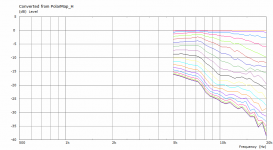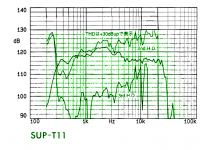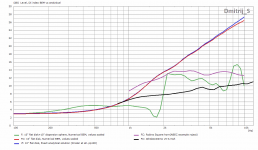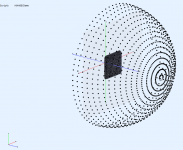Yeah, this does something. But is it really what we want?
- you mean like this:
WallImpedance "I1"
ImpType=Damping
RefElements="Horn"
Value=0.1
Value = 0.1:
Value = 0.5:
Yes, but even the value of 0.1 is to high. Typically I use the value around ~0.01
Code:
WallImpedance "internal_V2"
RefElements="internal_V2"
ImpType=Damping
Value=0.02Actually, you can find a real frequency-dependent absorption/impedance data of a typical plywood, aluminum etc. board and load the absorption table into ABEC3 using "DataFileAlias=" command (as I do sometimes)
Code:
WallImpedance "absorber_V1"
DataFileAlias=Z1
RefElements="absorber_V1"
ImpType=Impedance
NormalizedWhat is your target @mabat? It looks a lot like typical Tractrix-response to me with that gradually dropping energy response.
Ah, did you mean the "interface" (as in ABEC terminology)?
In the above the damping was added to the walls of the waveguide.
You understood correctly, damping should be applied to the walls, not interface (hmm, I have never tried to apply damping to the interior-exterior interface
 )
)Yes, but even the value of 0.1 is to high. Typically I use the value around ~0.01
Of course, I wanted to see if it also dampens the numerical issues. For the value of 0.1 there are still some and for 0.02 it makes really no difference here:
But I'm actually quite happy with how it is - the mesh is still pretty coarse (high calculation speed) and the results are usable.
Attachments
Last edited:
I would have thought that it would make no difference (as the interface should be completely transparent in principle), but Kees recently suggested otherwise (maybe I just didn't get it right, or don't remember it right).... hmm, I have never tried to apply damping to the interior-exterior interface
Last edited:
These are simulations of OS waveguides, as stated, so I don't quite understand what is the question 😕What is your target @mabat? It looks a lot like typical Tractrix-response to me with that gradually dropping energy response.
These are simulations of OS waveguides, as stated, so I don't quite understand what is the question 😕
I was just wondering if you were trying to create something new, and had some kind of design goal.
EDIT: But as I read some of the latest posts, it seems like you are trying to get the right settings for the software so it is as close to real life as possible?
By means of these simulations I try to understand how different things behave. The goal of this all is to make better waveguides, without any coloration or other linear distortion. Which seems to be already fulfilled BTW. Only in the highest octave there is still place for an improvement - that would take the spherical wave phase plug.
I would have thought that it would make no difference (as the interface should be completely transparent in principle), but Kees recently suggested otherwise (maybe I just didn't get it right, or don't remember it right).
Perhaps damping may be added to the internal-external interface, and there will be some effect. I don't know. But I usually add damping to the internal domain walls and leave the internal-external interface transparent.
The Phase-Plug
As I would consider waveguides basically done by now, the next goal is really the phase plug providing a spherical wave, improving the last octave (or so). Although I have already expressed my concerns about the real merit, it would certainly be exciting to have it. I just can't make the whole project on my own - I can prepare all the design tools for simulation but the actual fabrication is out of my reach at the moment (I'm thinking about SLA prints). Would there be anyone equipped and willing to participate in such a project?
As I would consider waveguides basically done by now, the next goal is really the phase plug providing a spherical wave, improving the last octave (or so). Although I have already expressed my concerns about the real merit, it would certainly be exciting to have it. I just can't make the whole project on my own - I can prepare all the design tools for simulation but the actual fabrication is out of my reach at the moment (I'm thinking about SLA prints). Would there be anyone equipped and willing to participate in such a project?
Last edited:
Please remember, if you create spherical wavefront at the exit of the cd, you dont want an os throat but only conical ( of course flared at the mouth). Try and simulate this, you will see large improvements.
And please dont think that the waveguide part is finished as long as you are simulating in infinite bafffle, it will make big differences in a finite baffle, accross the whole range, but especially it will matter everything in how much the cd will keep up at the lower frequencies.
And please dont think that the waveguide part is finished as long as you are simulating in infinite bafffle, it will make big differences in a finite baffle, accross the whole range, but especially it will matter everything in how much the cd will keep up at the lower frequencies.
Sure, this will be the waveguide formula: Cone+SE profile. You don't have to tell me that 😉
And I really do think the waveguides are done because even if there will be a difference in a finite baffle (and I don't believe it will be a big difference, at least not in +-60° off-axis where all the important happens), you just can't do anything about it - there's just no way how to improve it further, other than make it larger. You would have to show me some example where this is not the case.
And I really do think the waveguides are done because even if there will be a difference in a finite baffle (and I don't believe it will be a big difference, at least not in +-60° off-axis where all the important happens), you just can't do anything about it - there's just no way how to improve it further, other than make it larger. You would have to show me some example where this is not the case.
That's the reason I would like to try the phase plug... 🙂
Substantial improvements can be achieved in the plug phase, especially for larger diaphragms.
ATH4 is pretty much done.
Well, there is still one feature to be introduced, as I already announced before - free-standing, free-form waveguides, which will open a whole new world of possible shapes and outcomes. I only don't really believe it will bring much of an improvement to what we already have, what is meant to be used in a (rounded) box - a finite baffle.
... This is not surprising as we commonly see 2 inch drivers are not capable of exceeding useful output past 14kHz.
Admittedly, it's not a run-of-the-mill 2" driver (4" diaphragm), nevertheless its response - clean up to 23 kHz - clearly rebuts your statement.
It outperformed the TAD TD-4001 by a margin.
This 1990s driver was measured by renowned MJ Audio Technology, the oldest Audio magazine in the world.
Attachments
SLA would do it. I’m pretty sure you can get prints done online, we can chip in for the costs.The Phase-Plug
As I would consider waveguides basically done by now, the next goal is really the phase plug providing a spherical wave, improving the last octave (or so). Although I have already expressed my concerns about the real merit, it would certainly be exciting to have it. I just can't make the whole project on my own - I can prepare all the design tools for simulation but the actual fabrication is out of my reach at the moment (I'm thinking about SLA prints). Would there be anyone equipped and willing to participate in such a project?
What do you mean by "what was the horn"? This was a predecessor of the Tritonia waveguide I showed the renders of recently. I was actually an accident but worked pretty well. I could still reproduce the shape.
That is some serious effort, what you are doing, Dmitrij.
That is some serious effort, what you are doing, Dmitrij.
- Home
- Loudspeakers
- Multi-Way
- Acoustic Horn Design – The Easy Way (Ath4)



